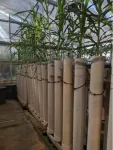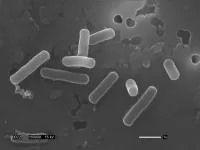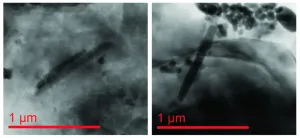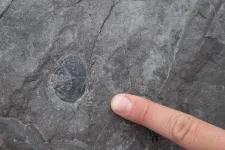(Press-News.org) Las Vegas, Nev. (Monday, Feb. 1, 2021) - In the summer of 2019, Desert Research Institute (DRI) scientist Rosemary Carroll, Ph.D., waited for the arrival of the North American Monsoon, which normally brings a needed dose of summer moisture to the area where she lives in Crested Butte, Colo. - but for the fourth year in a row, the rains never really came.
"2019 had just a horrendous monsoon," Carroll said. "Just the weakest monsoon. And we'd had a few years of weak monsoons before that, which had really gotten me wondering, how important is the monsoon to late summer streamflow here in the Upper Colorado River basin? And how do monsoons influence the following year's streamflow?"
Working in partnership with colleagues David Gochis, Ph.D., of the National Center for Atmospheric Research and Kenneth Williams, Ph.D., of Lawrence Berkeley National Laboratory, Carroll set out to explore the importance of monsoon rain in streamflow generation in a Colorado River headwater basin.
The team's findings, which are published in a new paper in Geophysical Research Letters, point to both the importance of monsoon rains in maintaining the Upper Colorado River's water supply and the diminishing ability of monsoons to replenish summer streamflow in a warmer future with less snow accumulation.
Their study focuses on the East River watershed, a pristine, high elevation, snow-dominated headwater basin of the Colorado River and part of the Watershed Function Scientific Focus Area (SFA) program that is exploring how disturbances in mountain systems - like floods, drought, changing snowpack and earlier snowmelt -impact the downstream delivery of water, nutrients, carbon, and metals.
Using a hydrologic model and multiple decades of climate data from the East River watershed, Carroll and her colleagues found that monsoon rains normally deliver about 18 percent of the basin's water and produce about 10 percent of the annual streamflow, with streamflow generated primarily in the higher elevations of the basin.
"The amount of streamflow produced by monsoons, while not geographically extensive, is actually somewhat substantial," Carroll said. "It was larger than I thought it would be. That doesn't mean all of that water gets to a reservoir -some likely is used by riparian vegetation or irrigation, but it still does go to meet some need within the basin."
Next, the team explored the ability of these summer rains to produce streamflow during cool years with high snow accumulation, and during warm years with less snow accumulation. During cool years with more snow, soil moisture levels were higher going into summer, and greater streamflow was generated by the monsoon rains. During warmer years with low snowpack, dry soils absorbed much of the monsoonal rains, and less runoff made it to the streams.
"You can think of the soil zone as a sponge that needs to fill up before it can allow water to move through it," Carroll said. "So, if it's already depleted because you had low snowpack, the monsoon then has to fill it back up, and that decreases the amount of water you actually get in the river."
As the climate warms, snowpack in the Rocky Mountains and other mountain systems is expected to decline, leading to reduced streamflow. Rising temperatures also lead to increased soil evaporation and increased water use by plants. According to the results of Carroll's study, these changes will reduce the ability of water from the monsoon to make it to the river as streamflow.
"Our results indicate that as we move toward a climate that is warmer and our snowpack decreases, the ability of monsoon rain to buffer these losses in streamflow is also going to go down," Carroll said. "So, the monsoon is not some silver bullet that is going to help mitigate those changes."
The Colorado River is a critically important resource for people living in Southern Nevada, where it accounts for about 90 percent of the water supply. Although runoff from winter snowpack provides a much larger proportion of streamflow each year than the monsoons, the monsoonal moisture is important to both ecosystems and people in part because it arrives at a different time of year. And in a system like the Colorado River, where every drop of water is allocated, if monsoon rains do not arrive, it creates a shortage somewhere downstream.
"In terms of water resources, if monsoon rains are useful and contribute to late-season streamflow, then the loss of that water obviously has implications for the ecology of these systems," Carroll said. "This water is really important in supporting aquatic habitat there. But it's also really important for human use. If any amount of water that we rely on isn't there, then something has to give. The Upper Basin will have to consider how they are going to manage their water to meet those downstream obligations."
INFORMATION:
Additional information:
The full text of the study, Efficiency of the Summer Monsoon in Generating Streamflow Within a Snow?Dominated Headwater Basin of the Colorado River, is available from Geophysical Research Letters: https://agupubs.onlinelibrary.wiley.com/doi/10.1029/2020GL090856
For more information on Rosemary Carroll, please visit: https://www.dri.edu/directory/rosemary-carroll/
For more information on the Watershed Function Scientific Focus Area (SFA) program, please visit: http://watershed.lbl.gov/
The Desert Research Institute (DRI) is a recognized world leader in basic and applied interdisciplinary research. Committed to scientific excellence and integrity, DRI faculty, students, and staff have developed scientific knowledge and innovative technologies in research projects around the globe. Since 1959, DRI's research has advanced scientific knowledge, supported Nevada's diversifying economy, provided science-based educational opportunities, and informed policymakers, business leaders, and community members. With campuses in Reno and Las Vegas, DRI serves as the non-profit research arm of the Nevada System of Higher Education. For more information, please visit https://www.dri.edu.
Oak Brook, IL - The February edition of SLAS Technology is a special collection of articles focused on "Artificial Intelligence in Process Automation" by Guest Editor Cenk Ündey, Ph.D. (Amgen, Thousand Oaks, CA, USA).
This SLAS Technology special collection targets the use of artificial intelligence (AI) techniques and technologies as applied specifically to drug discovery, automated gene editing and machine learning. As AI becomes increasingly more prevalent in research, medicine and even everyday life, laboratory automation has gone beyond hardware advancements toward new levels ...
Risk for a severe form of retinopathy of prematurity, which can cause blindness in extremely premature babies, was halved when the newborns were given a new supplement combining various fatty acids. This was shown in a Swedish study led from the University of Gothenburg.
The study, now published in JAMA Pediatrics, is described as groundbreaking in its field. It documents a clear fall in retinopathy of prematurity (ROP) among extremely premature (EP) infants (born before 28 weeks' gestation), whose retinal blood vessels are not fully developed. The condition can cause ...
When the body's immune response to an infection gets out of control, the result can be sepsis, a life-threatening condition in which an overwhelming inflammatory response can lead rapidly to failure of multiple organs and death.
In a new study, researchers at UC Santa Cruz have identified a long noncoding RNA (lncRNA) molecule that regulates the expression of pro-inflammatory genes in immune system cells called macrophages and affects the susceptibility of mice to septic shock.
This lncRNA, called GAPLINC, was previously studied for its role in cancer, but it turns out to be the most highly expressed lncRNA in macrophages, which play a central role in inflammation. ...
A previously unknown root trait allows some cereal plants to grow deeper roots capable of punching through dry, hard, compacted soils, according to Penn State researchers, who suggest that harnessing the inherited characteristic could lead to crops better able to deal with a changing climate.
"This discovery bodes well for American and global agriculture because the trait helps corn, wheat and barley grow deeper roots, which is important for drought tolerance, nitrogen efficiency and carbon sequestration," said Jonathan Lynch, distinguished professor in plant science. "Breeding for this trait should be helpful in developing new crops for climate mitigation."
Called multiseriate cortical sclerenchyma by the researchers -- or MCS -- the phenotype is ...
New research from North Carolina State University reveals that probiotic Lactobacillus bacteria use enzymes situationally to manipulate bile acids and promote their own survival in the gut. These findings further elucidate the complicated relationship between bile acids and gut bacteria and could eventually enable researchers to design lactobacilli with therapeutic properties, thereby engineering a healthier human gut environment.
Bile acids are key players in digestion and overall gut health. Produced in the liver and released after we eat, these acids not ...
Just as plants and animals on land are keenly attuned to the hours of sunlight in the day, life in the oceans follows the rhythms of the day, the seasons and even the moon. A University of Washington study finds the biological light switches that make this possible.
Single-celled organisms in the open ocean use a diverse array of genetic tools to detect light, even in tiny amounts, and respond, according to a study published Feb. 1 in the Proceedings of the National Academy of Sciences.
"If you look in the ocean environment, all these different organisms have this day-night cycle. They are very in tune with each other, even as they get moved around. How do they know when it's day? How do they know when it's night?" said lead ...
There are fossils, found in ancient marine sediments and made up of no more than a few magnetic nanoparticles, that can tell us a whole lot about the climate of the past, especially episodes of abrupt global warming. Now, researchers including doctoral student Courtney Wagner and associate professor Peter Lippert from the University of Utah, have found a way to glean the valuable information in those fossils without having to crush the scarce samples into a fine powder. Their results are published in Proceedings of the National Academy of Sciences.
"It's so fun to be a part of a discovery like this, something that can be used ...
Most snakes get from A to B by bending their bodies into S-shapes and slithering forward headfirst. A few species, however -- found in the deserts of North America, Africa and the Middle East -- have an odder way of getting around. Known as "sidewinders," these snakes lead with their mid-sections instead of their heads, slinking sideways across loose sand.
Scientists took a microscopic look at the skin of sidewinders to see if it plays a role in their unique method of movement. They discovered that sidewinders' bellies are studded with tiny pits and have few, if any, of the tiny spikes found on the bellies of other snakes.
The Proceedings ...
CAMBRIDGE -- The temperature of a planet is linked with the diversity of life that it can support. MIT geologists have now reconstructed a timeline of the Earth's temperature during the early Paleozoic era, between 510 and 440 million years ago -- a pivotal period when animals became abundant in a previously microbe-dominated world.
In a study appearing today in the Proceedings of the National Academy of Sciences, the researchers chart dips and peaks in the global temperature during the early Paleozoic. They report that these temperature variations coincide with the planet's ...
In a new study led by Yale Cancer Center, researchers have discovered a novel metabolic gatekeeper mechanism for leukemia. This mechanism depends on a molecule called PON2, which could lead to a new treatment for the disease. The findings were published online today in the Proceedings of the National Academy of Sciences (PNAS).
B cells are effector cells of the adaptive immune system and are marked by low energy levels, which prevent transformation to leukemia. In this study, Yale scientists identified high expression levels of the detoxifying lactonase ...









